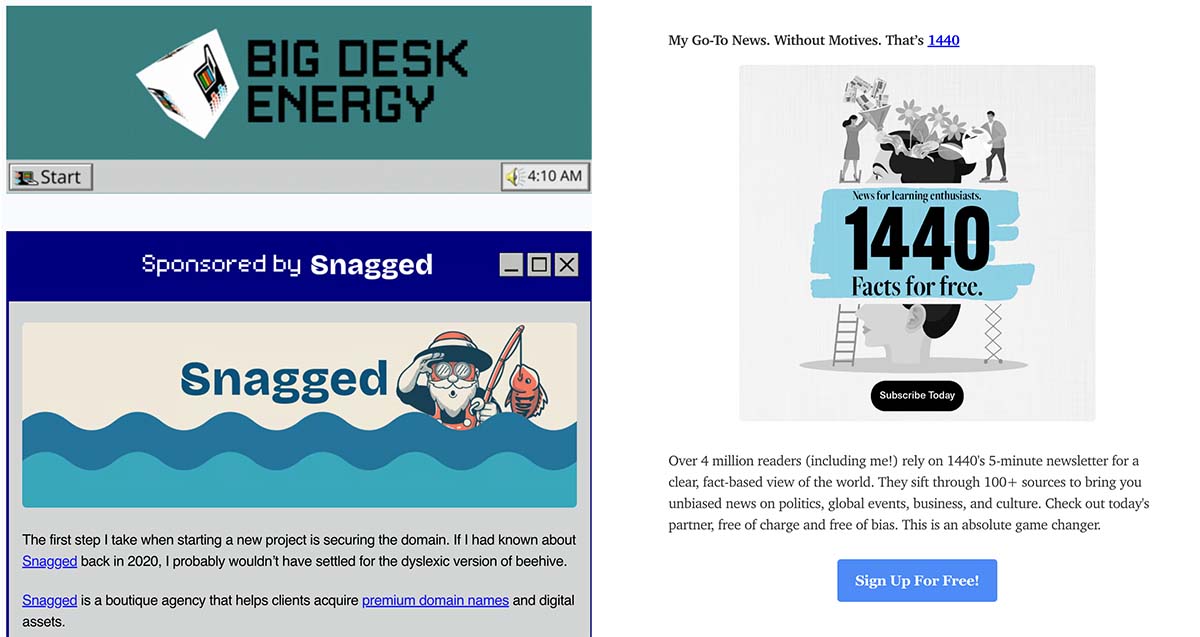4 Ways to Improve Newsletter Ad Revenue
Maximizing newsletter ad revenue is about pulling the right levers—choosing the best ad type, optimizing placement, aligning audience and advertisers, and growing a valuable subscriber base. The more precisely you adjust these factors, the more you can earn from every email sent.

Newsletter ad prices are not random. Supply, demand, and performance rule them, and while it may be impossible to control every aspect of the advertising revenue, creators (publishers) can control at least four levers.
Imagine an advertising generation machine built to produce money from newsletter advertising. To control the machine, the operator —creator or publisher— has a set of four levers.
Newsletter Ad Type
In the broadest sense, newsletter advertising may be divided into sponsorships or programmatic ads.
Celebrity creators generally sell advertising sponsorships that are personalized and paid via a flat rate. As an example, consider a recent sponsorship that ran in Tyler Denk's email newsletter, "Big Desk Energy." Denk is the CEO of beehiiv, a popular newsletter platform, and he has a large social media following.
In the February 11, 2025, edition of "Big Desk Energy," there is an ad from Snagged. The opening line of the advertisement is very personal to Denk. It reads, "The first step I take when starting a new project is securing the domain. If I had known about Snagged back in 2020, I probably wouldn't have settled for the dyslexic version of beehive."
This level of personalization and the massive amount of space the ad takes up in the newsletter is a strong indication of its value. Denk is getting top dollar.
For the next example, consider a 1440 ad that ran in Sahil Bloom's email newsletter on February 14, 2025. It is an affiliate sponsorship, but still a premium placement.

Sponsorships command higher rates but require significant effort. Denk and Bloom, for example, have large audiences and dedicated teams to manage their ad placements. For most publishers, this is not scalable.
Programmatic
For the majority of newsletter publishers, programmatic ads are a better choice. In this case, the ad is aimed directly at the individual subscriber. The effort is low, and the revenue is steady.
This lever is easy to pull because programmatic advertising simplifies newsletter sponsorships. As mentioned above, traditional sponsorships require managing different processes, payment terms, and requirements across multiple creators.
For CPC and CPA campaigns, programmatic is more effective. In 2025, many creator newsletters will run contextual ads—showing the same offer to all subscribers. But this approach wastes impressions on people who already use the product. Programmatic targeting fixes this by using suppression lists, ensuring ads reach only relevant subscribers.
Programmatic ads also scale. Sponsorships work for a handful of newsletters, but ad networks need automation to handle thousands. The best newsletter ad networks will be those that make targeted, performance-based ad buying seamless for advertisers.
For this type of advertising in 2025, try the Paved Ad Network.
Newsletter Ad Placement
The next lever a newsletter publisher can pull to impact ad revenue is placement. As I have previously written, newsletter advertisements that appear when a subscriber first opens the message are more than twice as valuable as other placements.
Data from more than a billion email newsletter impressions confirms what you likely already know. Ads near the top of an email perform better than those buried lower.
| Newsletter Ad Position | Ad Value |
|---|---|
| Below 4,000 pixels | 1 ad value unit |
| 3,000 to 3,999 pixels | 0.8 ad value unit |
| 2,000 to 2,999 pixels | 1.1 ad value unit |
| 1,000 to 1,999 pixels | 1.4 ad value unit |
| 0 to 999 pixels | 2.4 ad value unit |
Think about how you read newsletters. You open an email, scan the first section, and decide whether to keep reading. Naturally, ads placed higher get more attention. The data backs this up.
Audience
Content creators and publishers also have some control over the audience they serve. This lever is about whether or not a newsletter audience is attractive to advertisers and which advertisers those are.
Another way of thinking about the audience would be to imagine a dating game. The publisher needs to find the best audience-to-brand match possible. The better the match, the more the newsletter earns per subscriber.
Programmatic advertising plays this audience-matching game at scale. Instead of manually pairing brands with newsletters, programmatic platforms use data to match advertisers with the most relevant subscribers in real-time.
A well-matched audience increases ad performance, boosting revenue for both the publisher and the advertiser. Instead of relying on broad demographic guesses, programmatic pulls insights from subscriber behavior—what they read, which links they click, and even what devices they use. This precision means a travel newsletter can automatically serve different ads to frequent flyers and road-trippers, maximizing relevance and revenue.
For publishers, this means their audience becomes more valuable. The better the match, the higher the effective CPM or CPC, allowing newsletters to earn more per subscriber without needing direct sponsorship deals. Programmatic ensures that each ad impression is optimized, making every subscriber count.
Subscriber Count
The final lever impacting newsletter advertising revenue is subscriber count. While it is true that a newsletter creator who is also selling an online course for $999 can make a very nice living with a small email list, advertising is a numbers game.
Growing a newsletter is not just about adding subscribers; it is about understanding the typical subscriber's lifetime value. If each subscriber is worth $75 in ad revenue over 18 months, a publisher can strategically invest in growth.
Newsletter Ads

Maximizing newsletter ad revenue is about pulling the right levers—choosing the best ad type, optimizing placement, aligning audience and advertisers, and growing a valuable subscriber base. The more precisely you adjust these factors, the more you can earn from every email sent.